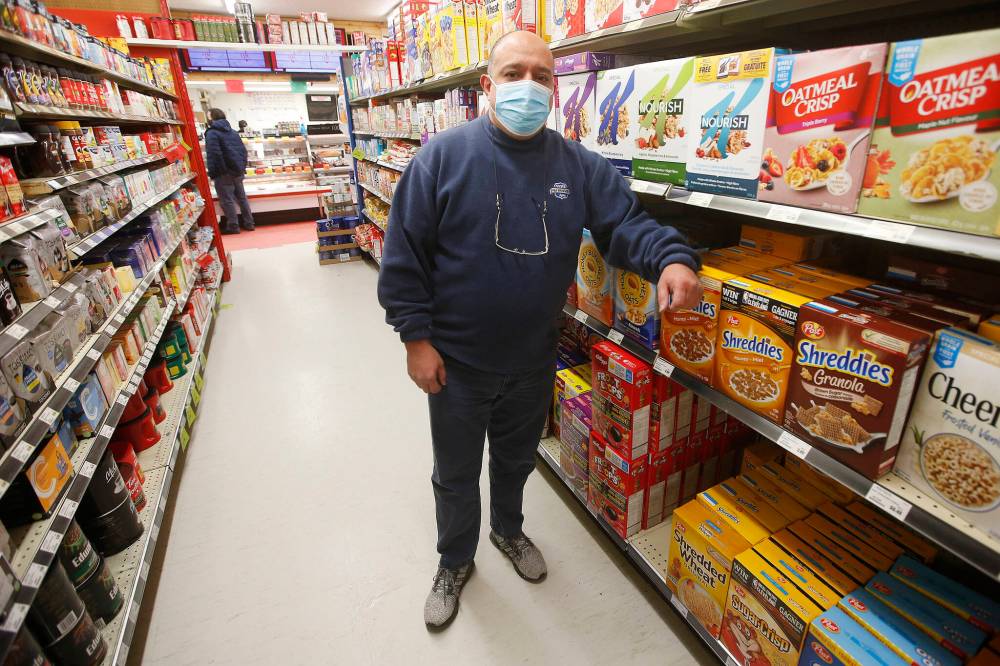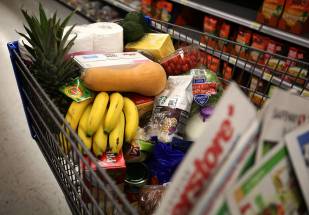‘Foodflation will remain an issue for a while’ Soaring grocery prices changing the way we shop: ‘There’s a sense of desperation out there’
Read this article for free:
or
Already have an account? Log in here »
To continue reading, please subscribe:
Monthly Digital Subscription
$0 for the first 4 weeks*
- Enjoy unlimited reading on winnipegfreepress.com
- Read the E-Edition, our digital replica newspaper
- Access News Break, our award-winning app
- Play interactive puzzles
*No charge for 4 weeks then price increases to the regular rate of $19.00 plus GST every four weeks. Offer available to new and qualified returning subscribers only. Cancel any time.
Monthly Digital Subscription
$4.75/week*
- Enjoy unlimited reading on winnipegfreepress.com
- Read the E-Edition, our digital replica newspaper
- Access News Break, our award-winning app
- Play interactive puzzles
*Billed as $19 plus GST every four weeks. Cancel any time.
To continue reading, please subscribe:
Add Free Press access to your Brandon Sun subscription for only an additional
$1 for the first 4 weeks*
*Your next subscription payment will increase by $1.00 and you will be charged $16.99 plus GST for four weeks. After four weeks, your payment will increase to $23.99 plus GST every four weeks.
Read unlimited articles for free today:
or
Already have an account? Log in here »
Hey there, time traveller!
This article was published 20/09/2022 (1174 days ago), so information in it may no longer be current.
Grocery prices haven’t risen this rapidly in 41 years.
“It’s getting outrageous,” said Vivian Owen.
A flyer stuck out of Owen’s purse as she trekked FreshCo aisles Tuesday. Pasta and ground beef have become her staple purchases.
Last month, food prices at stores were an average 10.8 per cent higher than in August 2021, according to Statistics Canada data released Tuesday.
Shoppers must look back to August of 1981, when food prices rose 11.9 per cent year over year, to beat last month’s rate.
“I have to ad match all the time,” Owen, 66, said. “(I’m) constantly looking for things that are on sale.”
“I have to ad match all the time… (I’m) constantly looking for things that are on sale.”–Vivian Owen, 66
A steak is a splurge for Owen, who said her pension is not keeping pace with the cost of living. Meat prices increased 6.5 per cent year over year.
Dairy products jumped seven per cent; bakery goods spiked 15.4 per cent last month compared to August 2021. Fresh fruit and condiment prices increased 13.2 and 17.2 per cent, respectively.
Owen’s partner sometimes gives her $20 for grocery shopping.
“I go, ‘You go grocery shopping and see what you can get for $20 these days,’” she said.
She believes she’ll be in food bank line-ups if prices continue to rise.
“I’m hoping that the government can do something,” Owen said. “They’ve got to do something to help the seniors out… the food banks are stressed as it is.”
“I’m hoping that the government can do something… They’ve got to do something to help the seniors out… the food banks are stressed as it is.”–Vivian Owen, 66
The province announced last month it would distribute $300 cheques to low-income seniors to help ease the burden of rising costs.
“Foodflation will remain an issue for a while,” said Sylvain Charlebois, a Dalhousie University professor of food distribution and policy.
Shoppers will continue to buy groceries differently than in the past, Charlebois said. Dalhousie University’s Agri-Food Analytics Lab released survey results on such changes Tuesday.
Twenty-three per cent of 5,000 Canadians surveyed said they’ve cut back on how much food they buy. Seven per cent reported skipping meals and snacks because of higher prices; six per cent said they pay for groceries with a credit card without knowing when they’ll pay it back.

“There’s a sense of desperation out there,” Charlebois said.
Some have taken smaller money-saving steps.
Sayde Bissell, 23, recently downloaded Flipp, an app showcasing grocery flyers.
“I pick where I shop based on wherever has a deal on chicken,” she said, carrying a packet of chicken breasts in a FreshCo basket. “Chicken’s so expensive.”
Bill Withoos scouts deals in store — he scored three bags of pasta for $5 and half-priced salami Tuesday. Still, he hasn’t cut back on buying food, he said.
“If you’ve gotta have it, you’ve gotta have it,” Withoos said.
Kelly Sebastyanko “shops around” and browses flyers. Nearly one-third of Dalhousie University survey respondents said they read weekly flyers more often.
“It’s a little frustrating because everything seems to be going up, and portions are getting smaller,” Sebastyanko said. “I don’t think (prices are) going to go down.”
“It’s a little frustrating because everything seems to be going up, and portions are getting smaller.”–Kelly Sebastyanko
She expressed confusion on where government money is going — “it doesn’t seem to be helping the people,” she said.
Customers are tending to buy necessities and items on sale, according to Munther Zeid, Foodfare’s owner.
“Pop… if it’s on deal, it moves. It’s not on deal, it sits. Chips, same thing,” Zeid said.
JOHN WOODS / WINNIPEG FREE PRESS Food Fare owner Munther Zeid says customers tend to purchase items on sale.
Many people have shifted to buying cheaper store brands, Scott Clement, owner of Dakota Family Foods, noted.
“We do have to do more price increases through the week than we’ve ever had to before,” he said, adding price increases from wholesalers come weekly.
It means grocers must adjust their price tags or take a cut from their margins.
“There is times where we don’t go over certain price points (when pricing items),” Clement said. “We might shave a little bit more of our margins so it doesn’t go over that.”
Extreme weather, Russia’s invasion in Ukraine and supply chain disruptions have led to increased food costs, said Michelle Wasylyshen, a spokeswoman with the Retail Council of Canada.
Zeid believes prices could come down with more wholesale competition.
Transportation costs and agricultural commodity prices are off their peaks, meaning grocery bills should stop ballooning soon, according to Andrew Grantham, senior economist at CIBC Capital Markets.
“Food price inflation should start to soften towards the end of this year and into 2023,” Grantham said in a client note.
Ruth Bonneville / Winnipeg Free Press files Last month, food prices at grocery stores were an average 10.8 per cent higher than in August. Dairy products jumped seven per cent while bakery goods spiked 15.4 per cent.
Overall inflation is slowing. In August, Manitoba’s inflation rate was eight per cent year over year, a decrease from the 8.8 per cent of July and the 9.4 per cent of June.
Still, the prairie province’s inflation rate is higher than the national average — seven per cent in August — with only Prince Edward Island surpassing it.
Nationally, gas prices fell 9.6 per cent on a month over month basis, the largest decline since April 2020.
It was still up 22 per cent year over year in August.
“I had to sell my summer car,” said Dan Mason, a FreshCo shopper.
He couldn’t afford the premium fuel to fill up his 1988 Ford Mustang, he said. Now, he pays around $120 a week for a half tank of gas in his truck.
“It’s kind of… ridiculous,” Mason said.
— With files from the Canadian Press
gabrielle.piche@winnipegfreepress.com

Gabby is a big fan of people, writing and learning. She graduated from Red River College’s Creative Communications program in the spring of 2020.
Our newsroom depends on a growing audience of readers to power our journalism. If you are not a paid reader, please consider becoming a subscriber.
Our newsroom depends on its audience of readers to power our journalism. Thank you for your support.










